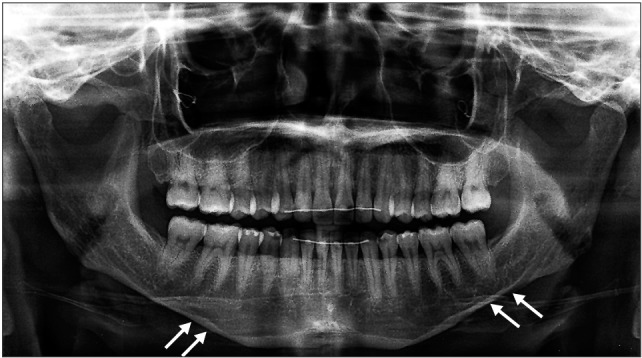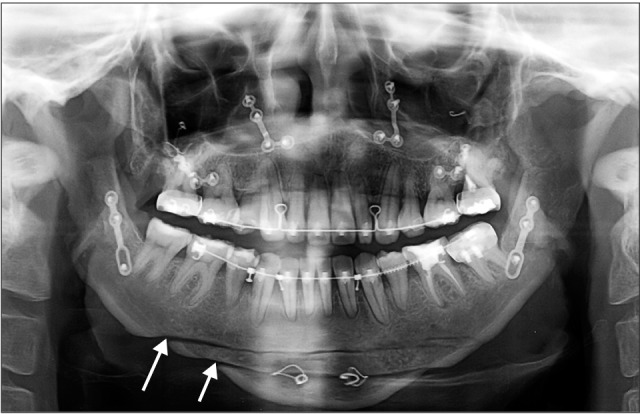J Korean Assoc Oral Maxillofac Surg.
2017 Oct;43(5):318-323. 10.5125/jkaoms.2017.43.5.318.
Inferior alveolar nerve cutting; legal liability versus desired patient outcomes
- Affiliations
-
- 1Oral and Maxillofacial Microvascular Reconstruction LAB, Brong Ahafo Regional Hospital, Sunyani, Ghana.
- 2Department of Oral and Maxillofacial Surgery, Dental Research Institute and School of Dentistry, Seoul National University, Seoul, Korea. leejongh@snu.ac.kr
- KMID: 2393597
- DOI: http://doi.org/10.5125/jkaoms.2017.43.5.318
Abstract
OBJECTIVES
Mandibular angle reduction or reduction genioplasty is a routine well-known facial contouring surgery that reduces the width of the lower face resulting in an oval shaped face. During the intraoral resection of the mandibular angle or chin using an oscillating saw, unexpected peripheral nerve damage including inferior alveolar nerve (IAN) damage could occur. This study analyzed cases of damaged IANs during facial contouring surgery, and asked what the basic standard of care in these medical litigation-involved cases should be.
MATERIALS AND METHODS
We retrospectively reviewed a total of 28 patients with IAN damage after mandibular contouring from August 2008 to July 2015. Most of the patients did not have an antipathy to medical staff because they wanted their faces to be ovoid shaped. We summarized three representative cases according to each patient's perceptions and different operation procedures under the approvement by the Institutional Review Board of Seoul National University.
RESULTS
Most of the patients did not want to receive any further operations not due to fear of an operation but because of the changes in their facial appearance. Thus, their fear may be due to a desire for a better perfect outcome, and to avoid unsolicited patient complaints related litigation.
CONCLUSION
This article analyzed representative IAN cutting cases that occurred during mandibular contouring esthetic surgery and evaluated a questionnaire on the standard of care for the desired patient outcomes and the specialized surgeon's position with respect to legal liability.
Keyword
MeSH Terms
Figure
Reference
-
1. Lee JH, Lee SY, Song SI, Lee EJ, Ahn KM, Kim SM, et al. Sensory normative values of lower lip and tongue for evaluation of inferior alveolar or lingual nerve damage. J Korean Assoc Maxillofac Plast Reconstr Surg. 2003; 25:114–122.2. Sunderland S. A classification of peripheral nerve injuries producing loss of function. Brain. 1951; 74:491–516. PMID: 14895767.
Article3. Morris DE, Moaveni Z, Lo LJ. Aesthetic facial skeletal contouring in the Asian patient. Clin Plast Surg. 2007; 34:547–556. PMID: 17692710.
Article4. Lee TS. Standardization of surgical techniques used in facial bone contouring. J Plast Reconstr Aesthet Surg. 2015; 68:1694–1700. PMID: 26346781.
Article5. Park BY, Kim MJ, Kang SR, Hong SE. A legal analysis of the precedents of medical disputes in the cosmetic surgery field. Arch Plast Surg. 2016; 43:278–283. PMID: 27218027.
Article6. Vila-Nova da Silva DB, Nahas FX, Ferreira LM. Factors influencing judicial decisions on medical disputes in plastic surgery. Aesthet Surg J. 2015; 35:477–483. PMID: 25908704.
Article7. Hultman CS, Gwyther R, Saou MA, Pichert JW, Catron TF, Cooper WO, et al. Stuck in a moment: an ex ante analysis of patient complaints in plastic surgery, used to predict malpractice risk profiles, from a large cohort of physicians in the patient advocacy reporting system. Ann Plast Surg. 2015; 74(Suppl 4):S241–S246. PMID: 25785388.8. Svider PF, Eloy JA, Folbe AJ, Carron MA, Zuliani GF, Shkoukani MA. Craniofacial surgery and adverse outcomes: an inquiry into medical negligence. Ann Otol Rhinol Laryngol. 2015; 124:515–522. PMID: 25595141.9. Svider PF, Keeley BR, Zumba O, Mauro AC, Setzen M, Eloy JA. From the operating room to the courtroom: a comprehensive characterization of litigation related to facial plastic surgery procedures. Laryngoscope. 2013; 123:1849–1853. PMID: 23299988.10. Vercler CJ, Buchman SR, Chung KC. Discussing harm-causing errors with patients: an ethics primer for plastic surgeons. Ann Plast Surg. 2015; 74:140–144. PMID: 24830658.11. Paik AM, Mady LJ, Sood A, Lee ES. Beyond the operating room: a look at legal liability in body contouring procedures. Aesthet Surg J. 2014; 34:106–113. PMID: 24259355.12. Patel AJ, Morrison CM. Opportunities to reduce plastic surgery claims through an analysis of complaints data. J Plast Reconstr Aesthet Surg. 2013; 66:455–459. PMID: 23312235.
Article13. Dyer C. Clinical negligence claims against plastic surgeons rise “significantly”. BMJ. 2012; 344:e298. PMID: 22234910.
Article
- Full Text Links
- Actions
-
Cited
- CITED
-
- Close
- Share
- Similar articles
-
- Updates on the Inferior Alveolar Nerve Block Anesthesia
- Diplopia after Inferior Alveolar Nerve Block Anesthesia: A Case Report
- Preliminary study on histologic changes in the nerve and surrounding tissues after inferior alveolar nerve transposition in rabbits
- Surgical Removal of Dental Implants Dislocated Into the Mandibular Body
- Facial blanching after inferior alveolar nerve block anesthesia: an unusual complication




